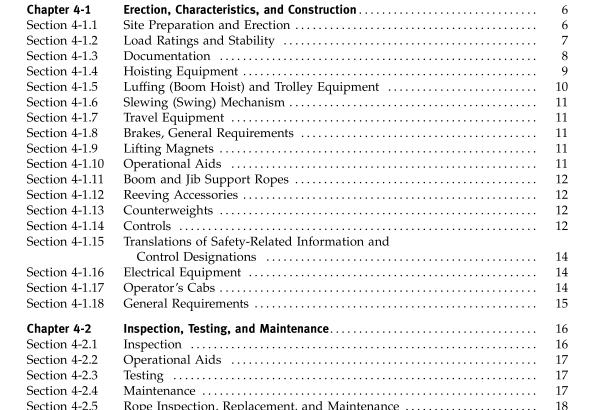ASME B30.4-2015 pdf free download.Portal and Pedestal Cranes Safety Standard for Cableways, Cranes, Derricks, Hoists, Hooks, Jacks, and Slings
SECTION 4-0.1: SCOPE OF B30.4 Volume B30.4 includes provisions that apply to the construction, installation, operation, inspection, testing, and maintenance of electric motor or internal- combustion enginepowered portal and pedestal cranes that adjust operating radius by means of a boom luffing mechanism or by means of a trolley traversing a hori- zontal boom, that may be mounted on a fixed or travel- ing base, and to any variation thereof that retain the same fundamental characteristics. This Volume appliesonlytoportalandpedestalcranes utilizing a drum and wire rope for hoisting and that are used for hoisting work. The requirements for tower cranes (refer to ASME B30.3), telescopic boom cranes, twin boom container handling cranes, and articulating boom cranes are not included in this Volume.
SECTION 4-0.2: DEFINITIONS 4-0.2.1 Types of Cranes luffing crane: a crane with a boom pinned to the super- structure at its inner end and containing load-hoisting tackle at its outer end and with a hoist mechanism to raise or lower the boom in a vertical plane to change load radius (see Figs. 4-0.2.1-1 through 4-0.2.1-3). pedestal crane: a crane consisting ofa rotating superstruc- ture with operating machinery and boom, all of which is mounted on a pedestal (see Fig. 4-0.2.1-1). portal crane: a crane consisting of a rotating superstruc- ture with operating machinery and boom, all of which is mounted on a gantry structure, usually with a portal opening between the gantry columns or legs for traffic to pass beneath the crane. The crane may be fixed or on a traveling base (see Figs. 4-0.2.1-2 and 4-0.2.1-3).
4-0.2.2 General accessory: a secondary part or assembly of parts that contributes to the overall function and usefulness of a machine. administrative or regulatory authority: governmental agency or the employer in the absence of governmental jurisdiction.
alteration (modification): any change in the original equipment manufacturer’s design configuration of the crane that pertains to load-supporting components, load-posi- tioning components, and other components that affect the safe load-carrying capability of the crane (e.g., counterweights, holding valves), including operational aids, limit devices, and other safety equipment. axis ofrotation: the vertical axis around which the crane superstructure rotates.
bogie: an assembly of two or more axles arranged to permit both vertical wheel displacement and an equalization of loading on the wheels. boom: a member used for supporting the hoisting tackle, hinged to a fixed or rotating structure or to a mast, with its outer end supported by ropes, chains, rods, or hydraulic cylinder(s).
boom point: the outward end of the load-bearing boom. boom stop: a device or structure designed to limit boom travel to its highest allowable position. brake: a device, other than a motor, used for retarding or stopping motion by friction or power means.
braking means: a method or device for retarding or stop- ping motion. buffer/bumper: an energy-absorbing device for reducing impact when a moving boom or crane reaches the end of its permitted travel.
cab: a housing provided for the operator and containing the crane controls. clutch: a means for engagement or disengagement of power.
counterweight: weight used to supplement the weight of the machine in providing stability for lifting working loads; it swings with the crane.
crane, standby: crane that is not in regular service but used occasionally or intermittently as required. drum: the cylindrical member around which a rope is wound and through which power is transmitted to the ropes.ASME B30.4 pdf download.ASME B30.4-2015 pdf free download
